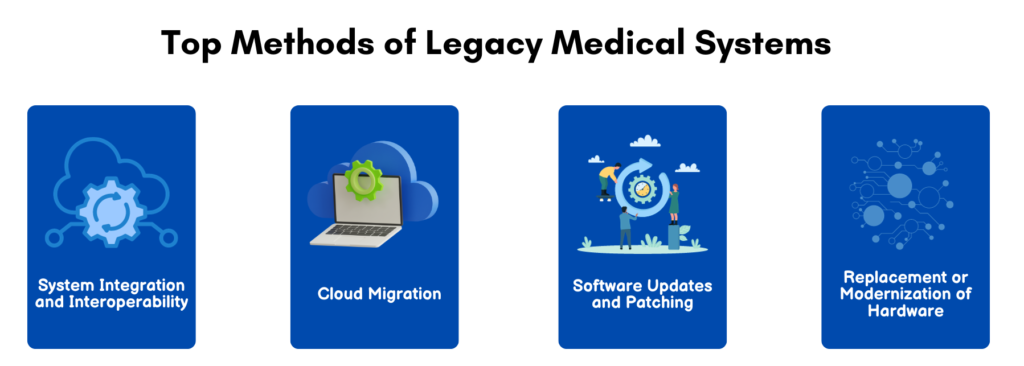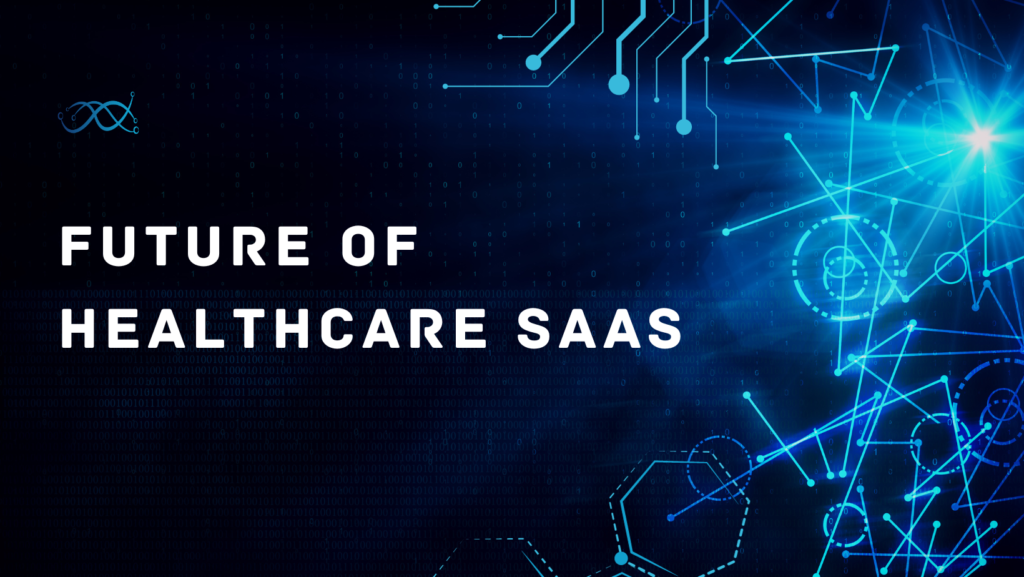Legacy Systems in Healthcare Meet the Power of HealthTech Business Intelligence
In the contemporary healthcare landscape, incorporating advanced technologies into solutions is not merely a preference but a requisite for ensuring operational efficiency, enhancing data interoperability, and delivering optimal patient care aligned with evolving industry standards. The revitalization of legacy systems through HealthTech innovation is imperative for establishing a digitally transformed healthcare ecosystem.
The urgency to modernize legacy systems in the healthcare sector arises from the rapid progression of technologies, including artificial intelligence, robotic process automation, and machine learning.
This article will explore the necessity of modernizing legacy systems in healthcare, the various types of legacy healthcare systems, key methods for upgrading legacy medical systems, instances of healthcare legacy systems modernization, the associated challenges, and potential solutions to overcome them. Let’s delve deeper into these aspects.
Understanding the Need for Healthcare Legacy System Modernization
In the healthcare context, legacy systems pertain to software that no longer undergoes updates or enhancements from its initial vendor. Despite serving essential functions, these systems remain static in terms of development, remaining in their original state. Remarkably, more than 70% of Fortune 500 companies continue to rely on legacy systems, underscoring their enduring prevalence.
Legacy systems in healthcare, characterized by outdated technologies, pose various challenges, such as interoperability issues, security vulnerabilities, and limited scalability. As the healthcare industry progresses towards digitization and data-driven decision-making, modernizing these systems becomes critical to enhance patient care, streamline workflows, and comply with evolving regulatory standards.
Exploring the Types of Legacy Healthcare IT Systems
Healthcare IT systems have undergone substantial evolution, resulting in diverse types of legacy systems utilized across healthcare environments. These systems differ in functionality, technology, and the era of their development. Several primary categories of Legacy Systems in Healthcare IT systems encompass.

Electronic Health Record Systems (EHR):
Digital storage of patient health data within these systems encompasses medical histories, diagnoses, medications, treatment plans, immunization records, allergies, radiology images, and laboratory test results. Variations among legacy EHR systems can be observed in their interfaces, data storage methods, and interoperability standards.
Picture Archiving and Communication Systems (PACS):
Legacy PACS systems play a crucial role in managing medical imaging, encompassing X-rays, MRIs, CT scans, and ultrasound images within healthcare settings. Nevertheless, these legacy systems in healthcare may face limitations related to storage capacity, image quality, and integration with other systems, impacting their overall effectiveness.
Hospital Information Systems (HIS):
HIS encompasses a broader range of functionalities including patient registration, appointment scheduling, billing, and administrative functions. Legacy HIS systems may lack modern integration capabilities and user-friendly interfaces.
Laboratory Information Systems (LIS):
LIS manages data from clinical laboratories, including test orders, specimen processing, and results. Older LIS systems might need more connectivity with other Legacy systems in healthcare.
Claims Processing Systems:
Responsible for handling billing and reimbursement processes between healthcare providers and payers, these systems face a significant challenge due to the complexities of contemporary billing rules and regulatory changes, especially when operating on outdated infrastructures.
Telemedicine Systems:
Legacy telemedicine systems are outdated components within the healthcare communication infrastructure. These systems need to undergo upgrades to ensure secure communication and enable the delivery of effective telehealth services.
The experts at Digiatto IT Services played a crucial role in enhancing YouCOMM, a robust healthcare system. They introduced additional features that substantially improved the real-time response rates of in-hospital nurses.
Patient Engagement Systems:
Many early patient engagement systems lack the user-friendly interfaces and features found in modern solutions. Upgrading these systems is essential to encourage active patient involvement in their healthcare.
As the healthcare landscape evolves, it becomes imperative to transform these outdated legacy systems to meet the demands of data security, interoperability, and technological advancements. Now, let’s explore the approaches to upgrading legacy medical systems.
Top Methods of Upgrading Legacy Medical Systems in Healthcare
The process of updating outdated healthcare data systems involves strategic methods to modernize and improve these older solutions, ensuring they meet current industry standards and technological advancements. Below are some key steps in the modernization of legacy healthcare systems.

Evaluation and Record Keeping
Evaluate the existing legacy systems meticulously, assessing their reliability, functionality, and data structures. Document precise specifications and integration objectives while considering security and scalability.
Specify Integration Goals
Specify integration goals clearly, whether focused on improving data flow, enhancing functionality, or ensuring compliance with advanced technologies. Align these goals with the broader objectives of the healthcare organization to ensure the integration strategy contributes to overall business success.
Choose an Integration Method
Select an integration method based on evaluated requirements and existing infrastructure. Options include data migration, APIs, middleware, or a combination. Consider the long-term sustainability and scalability of the chosen method to align with the organization’s evolving needs.
Integration of Middleware
For middleware integration, ensure it enables communication between contemporary and legacy systems. Configure middleware to facilitate smooth data transport and system interoperability.
API Integration
When using APIs, choose or create ones compatible with both contemporary and legacy applications. Implement robust authorization and authentication procedures to safeguard data during integration.
Data Migration
Plan and execute the data migration process from old legacy systems to the new environment. Validate the consistency and accuracy of migrated data.
Testing
Thoroughly test integrated systems to ensure they function as intended. Conduct user acceptability, integration, and unit testing to identify and address bugs and glitches.
Implementation
Adopt a phased and gradual approach to implementation to minimize disruptions to routine operations. Monitor the integration process and address challenges promptly.
Monitoring and Optimization
Utilize monitoring tools to track user feedback and system performance. Continuously upgrade integrated systems to meet changing business requirements and user expectations.
Healthcare legacy system modernization approaches aim to create a more unified and efficient IT infrastructure that adapts to evolving healthcare sector needs. Exploring the top use cases of legacy systems in healthcare can provide a deeper understanding of these efforts.
Healthcare Legacy System Modernization Use Cases and Examples
By improving data interoperability to streamline patient care and incorporating AI driven analytics for informed decision-making, these widely adopted applications of legacy systems in healthcare showcase the concrete advantages of modernizing outdated healthcare systems.
Mayo Clinic’s EHR Platform Modernization
Mayo Clinic, a prominent healthcare provider, has successfully concluded a $1.5 billion initiative to modernize its electronic health records (EHR). Starting in Wisconsin, Mayo Clinic systematically migrated existing Cerner and General Electric systems to the Epic EHR platform. This strategic progression prioritizes smaller clinics and remote locations, consolidating Epic’s influence in large healthcare organizations.
This technological upgrade enables Mayo Clinic specialists to leverage advanced solutions and collaborative care systems linked to their electronic health records, facilitating high-quality treatment, cutting-edge research, and educational support.
Siemens Healthineers’ Diagnostic Imaging System Evolution
Siemens Healthineers addressed outdated diagnostic imaging challenges affecting accuracy and efficiency by integrating innovative solutions with AI integration.
This transformative approach enhances healthcare providers’ diagnostic precision through advanced image analysis capabilities, improving patient outcomes.
Cleveland Clinic’s Digital Transformation
The Cleveland Clinic spearheaded a comprehensive digital transformation over the past decade, revolutionizing medical practices. Embracing telemedicine to enhance provider efficiency and adapt to bundled payments, the Cleveland Clinic offered patients a sensible and cost-effective alternative to in-person consultations. This swift digital transformation expanded telehealth service accessibility from 2% to an impressive 75% within two weeks.
Optum360’s Billing and Revenue Cycle Management Optimization
In response to challenges posed by outdated billing systems causing errors and delays in revenue cycle management, Optum360 introduced a comprehensive solution. Leveraging advanced automation and data analytics technology, Optum360 implemented sophisticated billing and revenue cycle management systems. This tactical approach aimed to eradicate billing errors, expedite reimbursement cycles, and enhance the financial stability of healthcare organizations.
These examples illustrate the diverse benefits of healthcare legacy systems. Now, let’s explore the challenges associated with these systems and potential solutions to address them.
Legacy Systems in Healthcare Challenges and Solutions to Overcome Them
The challenges associated with legacy systems often revolve around interoperability, security risks, and high maintenance costs. Solutions include incremental modernization approaches, employing middleware for data integration, robust cybersecurity measures, and partnering with tech firms specializing in healthcare IT modernization.
Interoperability Challenges:
Addressing interoperability issues in outdated healthcare systems is crucial for seamless data exchange. The adoption of standardized data formats, such as Fast Healthcare Interoperability Resources (FHIR), provides a common language for effective communication within the industry.
Additionally, the implementation of middleware solutions enhances the capability to translate and integrate data, promoting a smooth flow of information. This strategic integration not only overcomes the limitations of legacy systems but also establishes the foundation for a more interconnected and interoperable healthcare environment.
Outdated User Interface:
Revamping outdated user interfaces is essential for improving the overall user experience and operational efficiency in healthcare settings. Introducing user-friendly interfaces with intuitive designs facilitates more intuitive and productive work for healthcare professionals.
Robust training programs should accompany these changes to ensure that users are proficient in navigating and utilizing the new interfaces, leading to a seamless transition. This commitment to updating user interfaces enhances the overall user experience, boosts efficiency, and elevates the standard of patient care.
Security Concerns:
Addressing security issues in older healthcare systems is critical to safeguard patient data from potential threats. Establishing a robust defense against threats involves implementing intrusion detection systems, conducting routine audits, and employing encryption – key components of a comprehensive cybersecurity strategy.
Another strategic option involves transitioning to contemporary platforms with robust data security features. Healthcare organizations should fortify their digital infrastructure to ensure the safety and confidentiality of critical patient data, remaining vigilant against malicious cyberattacks.
Patient Engagement:
Proactive modernization is essential to overcome legacy system-related constraints on patient engagement. The implementation of integrated patient portals, mobile applications, and communication tools expands the options for interaction, fostering a more informed and engaged patient community.
Additionally, the use of personalized health records enhances participation by providing individuals with easily accessible and customized health information.
The success story of Health-e-People exemplifies the impactful outcomes of healthcare IT consulting services. As a multi-dimensional healthcare platform, Health-e-People delivers user-centric solutions to patients, streamlining their healthcare records. Through the expertise of our professionals, Health-e-People has become the leading user-centric healthcare platform, benefiting both caregivers and patients.
How Can Digiatto IT Services Help You Modernize Your Healthcare Legacy Systems?
The potential transformation of patient care through healthcare applications relies heavily on their integration with existing legacy systems in the healthcare sector. Despite the challenges, the modernization of legacy healthcare IT systems brings numerous advantages. Therefore, the future of healthcare demands a harmonious coexistence of legacy systems and modern applications, promising enhanced patient outcomes and overall system efficiency.
Digiatto IT Services focuses on simplifying the integration of advanced technologies with legacy healthcare systems, which remain the backbone of the healthcare industry. Businesses stand to gain from this connectivity by experiencing improved data accessibility, accelerated processes, increased patient interaction, and reinforced compliance and security measures.
Our healthcare software development services pave the way for a healthcare ecosystem prepared for the future. This ecosystem ensures that legacy healthcare IT systems seamlessly interface with state-of-the-art applications, fostering continuous advancements in patient care and operational excellence.
Are you ready to embark on the journey of updating your legacy systems in healthcare? Reach out to our experts today!



Pingback: Digital Transformation in Healthcare Industry - Health SaaS Pro
Pingback: Role of Cloud Computing in Healthcare Industry - Health SaaS Pro
Pingback: Improving Electronic Health Records in 2024 - Health SaaS Pro
Pingback: Legacy Application Modernization Strategy - HealthSaaSPro